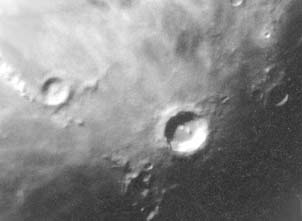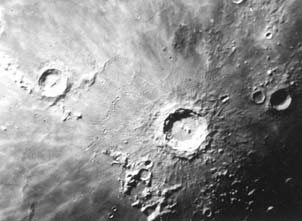It is actually possible to see all the Messier objects (often considered the 108 most popular objects in the sky) with a 1" aperture telescope using no more than 40x magnification. A big scope is not needed to see deep space objects, but to see them well is another story.
While there are quality differences among telescopes and telescope types, so that one manufacturer's 3.5" Maksutov may show more detail than another manufacturer's 8" Schmidt-Cassegrain under the right seeing conditions, a good rule of thumb is simply this: buy the largest aperture telescope you can afford. An examination of the photographs below will show why.

3.5" scope photo courtesy Celestron

14" scope photo courtesy Celestron
Both were taken using eyepiece projection, using different eyepieces to produce the same image scale. The upper photo was taken through a 3.5" Celestron scope. It's acceptable, but no match for the high resolution photo on the bottom, taken through a 14" Celestron. The moral is obvious - all other things being equal, the bigger the scope, the more detail you see.
But a large aperture has a more important benefit than simply higher resolution (which is all too often limited by seeing conditions anyway). Many deep space objects are very large, but very faint. To see them, you need to make their images brighter, not bigger. The larger the telescope aperture, the brighter the image at any given power - plus, it's easier to see detail in a bright image than it is in a dim one.
Keep in mind, however, that using a big scope to see faint objects from a light-polluted city doesn't make a lot of sense. All you'll see is light pollution. You'll spend a lot of time hauling a big scope to the dark skies it needs to operate to its full capacity. Use the rule of thumb for judging usable aperture size in the city and suburbs in our website section on transparency.
If you always have to observe from a light-polluted city or suburban site, don't buy more aperture than your light pollution conditions will let you use. If you have frequent access to a dark sky observing site, however, buy a big scope that will let you take full advantage of those dark skies. The rest of the time, in the light-polluted city, observe only those small, bright objects that can punch through the light pollution - the Moon, planets, star clusters, and binary stars. Save the faint fuzzies outside the solar system for those times when you can get to your dark sky site.
To sum up: outside the solar system, more light and more detail at any power is better than useless (but impressively high) empty magnification. Outside the solar system, the bigger the aperture, the more you'll see. Inside the solar system, it's sometimes another matter.
It doesn't make sense to get a 10" scope if your major interest is observing the planets. You'll be looking at the tops of sun-lit clouds for the most part, and a large scope will make those cloud tops so bright that irradiation within your eye caused by their glare will wash out the very faint details you want to see. Using a big telescope to look at the planets is like trying to read the name on a car headlight at night when its lit. Things get too bright to see any faint detail. And people will look at you strangely if you put on sunglasses to look through your telescope.
Also, keep in mind that a large scope looks through more of our atmosphere than a small scope, and is therefore more affected by seeing conditions. An 8" scope looks through four times as much turbulent air as a 4" scope. At any given power, then, the skies essentially have to be four times better with an 8" scope than they do with a 4" scope to see the same amount of detail at high power. If you live in an area with frequently turbulent skies, where the stars are always twinkling (a sure sign of unsettled atmospheric conditions), don't count on being able to use a large scope at high powers very often. A smaller scope that looks through less of the turbulence will often be more useful to you for planetary observing.
People talk of skies that are still enough to provide one arc second seeing as being excellent for observing. But skies that calm at all altitudes are very rare. Professional observatories are sited on mountain tops above much of our turbulent atmosphere, where they hope to have sub arc second seeing many nights out of the year, or they're located outside our atmosphere, as is the Hubble Space Telescope. But one arc second is about the resolution of a 4.5" to 5" telescope. That means that on the more-typical nights of average seeing from the altitudes where most of us live, we can see no more planetary detail through a 10", 12" or 16" scope than we can through a 5" to 6". The quality of the atmosphere is often the limiting factor when it comes to seeing detail, not the quality of the optics - or their size.
So, if you're a planetary observer, take our "bigger is better" rule of thumb with a large grain of salt. Big scopes can often mean big problems for the primarily planetary observer - problems of light pollution, poor seeing conditions, irradiation within your eye, and the "oh, boy, do I want to haul out my 150 pound scope and wait an hour for it to cool down to operating temperature for probably just a few minutes of good to very good seeing during maybe hours of so-so high magnification observing" syndrome. From the standpoint of practicality, a small to medium size long focal ratio reflector, Maksutov-Cassegrain, or medium size refractor may match your lunar/planetary observing requirements better than a big scope, no matter how much additional resolution the big scope will provide under optimum (and rare) seeing conditions.
But, if you're a deep space observer, buy the biggest scope you can afford - not just financially, but from a size/weight/light pollution standpoint as well. But don't go overboard in size. Don't get a scope that's so big and heavy you can never get up the strength to move it, even if your budget can handle it. While bigger is better optically on the faint fuzzies outside the solar system, and even on planetary detail within the solar system on those rare occasions when atmospheric conditions permit it, the best scope is not necessarily the one with the biggest or most expensive optics - it's the one you use most often. And you're more likely to take out a medium size 8" scope than a 16" monster.








